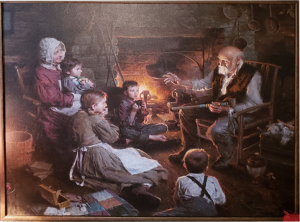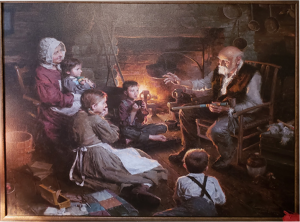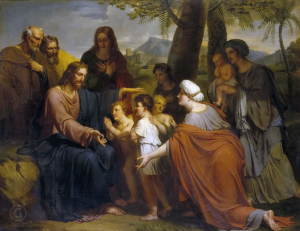
One major challenge of the post-modern family is to compete with technology for entertainment during family gatherings. We commonly see family and friends glued to their electronic devices. Psychologists have even come up with a term to label the practice. It is called this phubbing or phone snubbing. It means to snub others next to you so you can socialize on your phone. Seventy percent of millenials admit they have escaped conversations and secluded themselves in the bathroom or an isolated corner of the house to check their social media.
The modern family has relied so much on “technology” for entertainment. Over the past century, we have seen the gramophone, the movie theater, the radio, the television, cable TV, the internet, video games and the smartphone. Indeed, we have forgotten other superior forms of entertainment. Unwittingly, social media technology has made it easy to forge wedges between family members.
One timeless form of “forgotten” entertainment is storytelling. The Greeks had their comedies and tragedies. The Medieval ages had their bards. Victorian England had their theater plays. Even tribal socieites have had their legends and lore.
The appeal of storytelling is so attractive that it has been incorporated into standard marketing practice. Seth Godin, author, marketer and public speaker, says that “Marketing is no longer about the stuff that you make, but about the stories you tell.”
Yet, fewer and fewer families give importance to it. As a consequence, the spiritual fruits of storytelling are disappearing.
Help Remove Jesus Toilet Lid on Amazon
As families gather on holidays, it is timely to list the main benefits of storytelling. We will use three pictures to help us with our narrative.

Forging Spiritual Bonds Through Storytelling
In this picture, we see an older brother reading a story to his younger siblings. There is an endearing interaction between storyteller and listeners. As the story progresses, the younger siblings are drawn deeper into it.
Evidently, something amusing is happening in the story. The girl can hardly contain herself. She seems to forget she is sitting on the arm of the sofa and teeters on the edge of the couch. Her hands are clasped together and held close to her chest as if unwilling to let her heart flutter away. She fails to hold her delight in and lets out a cheerful laughter.
Satanic Christ Porn-blasphemy at Walmart — Sign Petition
The boy to the left of our storyteller is enchanted by the story. He is tucked in snugly between the crack in the cushion and the storyteller as if in hiding. He too has been swept away as he giggles to the point of forgetting about sucking upon his thumb.
The third sibling is also captivated by the story. With a smile on his face and nothing but attention in his eyes, he leans closer to his older brother.
Something is taking place inside the souls of these children. A well-told story transcends the plot. The story is merely the a medium that makes it easier for a soul to touch another soul. It is the means to communicate certain truths, beauty and goodness. Jimmy Neil Smith, Director of the International Storytelling Center, rightly states; “There isn’t a stronger connection between people than storytelling,”
How Panera’s Socialist Bread Ruined Company

Instilling Family Traditions and Values Through Storytelling
In this picture, a grandfather tells of how he acquired an old family treasure: a peace pipe.
Is it the Indian chief who owned the peace pipe he is talking about? Is it about his past life as a trader, cowboy or colonist? Much is left to our imagination and even more to the grandchildren as they sit around the old man enraptured by his story.
The girl, sitting in front of Grandpa, seems almost anxious and uncomfortable. She bites her fingernails nervously in anticipation to a thrilling turn of events in the story while her younger sister grips her teddy bear tighter as if to protect it from an approaching danger.
The boy next to the fireplace has a most precious expression. He is completely lost in thought and has drifted to unknown adventures. His own mind’s journey has gripped him so tightly he has forgotten about his cup of hot chocolate. Time has stopped for him. His cup is suspended a few inches from his lips frozen in the act of sipping. The artist aptly paints the flames in the fireplace shaping his profile creating a dramatic backdrop to wherever his imagination has taken him.
In turn, grandpa has temporarily lost the aches and pains of his old age as he relives old experiences. Youth is restored to him as he waves his hand in a wide arch reaching a climax to this story. In this moment, everyone has forgotten grandpa’s old age as they relive his youthful memories together.
Listening to grandpa’s experiences, the grandchildren are given the chance to see what he saw, smell what he smelled, and most importantly to live as he lived. The story again becomes the means to transmit concepts like family virtues, customs and traditions. It is a perfect way of transmitting values important to the family.
Such storytelling also serves as an important vehicle for the balanced psychological growth of children. It is not only the lore that attracts the children but also learning an unknown part of their history.
It is as if a leaf on a tree were to look around and see the twig, then the branch, then the limb and the whole trunk from whence it came. Then it would recognize its ancient origins and feel more connected to the rest of the tree. Looking back at the rest of the tree gives its life form and purpose. It sees that it is not a random offshoot, but a vital part for the tree.
The spiritual result of this process can provide a much needed psychological equilibrium for children today.
The Greatest Story Ever Told
Professor Robert McKee says “Storytelling is the most powerful way to put ideas into the world.” No one knew the importance of storytelling better than Our Lord Jesus Christ. No one put it into practice more effectively than He did. Indeed, not only are the Gospels full of parables, but the Scriptures themselves are full of stories, each one more fascinating than the other.

This picture portrays the scene when Our Lord says to suffer the children to come to Him.
As Our Lord’s preaching becomes known, multitudes gather to hear Him. They come to hear words of wisdom and eternal life. Yet, He tells them stories. Hidden behind them are truths and principles of salvation and holiness.
He did not talk to them as an unaccomplished college professor who drones his lectures unaware, perhaps, uncaring of nodding heads and glazed eyes. Jesus is the master storyteller. Nay, He is the Divine Storyteller. His Grace transformed His stories into powerful tools of conversion. So captivating is His preaching that children begged to approach so as to be close to Him. So profound are His lessons that sinners from all over Judea came to hear words of balsam. So powerful were His words that they would convince converts to lay down their lives as martyrs rather than to give up the faith. So persuasive were His arguments that Pharisees and Scribes were reduced to silence.
Jesus took storytelling to a different level. Who could imagine that parables could serve to help change the lives of individuals, families, communities, nations and even entire continents? With the aid of Divine Grace, the apostles were sent all over the Earth armed with these parables. Such is the effect of storytelling utilized in its highest and most noble way.
As noted in the first picture, the storyteller transcends the story. So does Jesus transcend His parables. Through them, one can see the very countenance and personality of the Word Incarnate.
[like url=https://www.facebook.com/ReturnToOrder.org]
What Stories Will You Tell? What Values Will You Pass On?
It will not be easy to overcome the allure of technology over other forms of entertainment. Yet, we should think of what is lost when they are abandoned. If family bonds are to be restored, if the advance of phubbing is to be stopped, we must do more than just criticize technology. We need a replacement. Nothing could be more beneficial to the family and society than restoring the art of storytelling.
Perhaps, it is not too late with your family. The holidays, especially Christmas, are good opportunities to try to restore the story to its exalted place in the family. After all, nothing speaks of storytelling than the very birth of Jesus what some have called the greatest story ever told.


